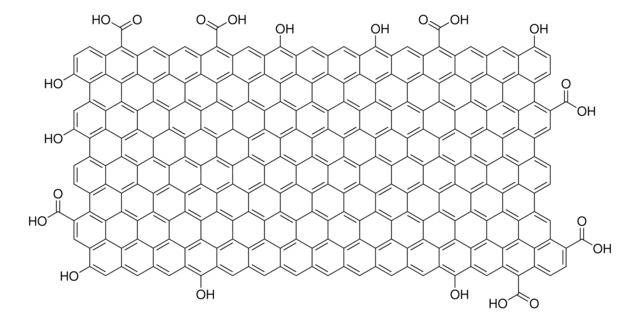The surface area and pore size are not determined for this product.
808121
Expandable Graphite
flakes
Synonym(s):
Graphite intercalation compound, Intumescent flake graphite
About This Item
Recommended Products
description
Expansion Ratio (X:1): 270 to 325
Quality Level
form
flakes
particle size
+50 mesh (>300μ, ≥75% minimum)
pH
5-10
solubility
water: insoluble
Related Categories
General description
If exposed to a rapid increase in temperature, these intercalation compounds decompose into gaseous products, which results in high inter-graphene layer pressure. This pressure develops enough force to push apart graphite basal planes in the “c” axis direction. The result is an increase in the volume of the graphite of up to 300 times, a lowering of bulk density, and approximately a 10-fold increase in surface area.
Application
- Graphene precursor.
- Inorganic source of carbon.
- Filler.
- Thermal additive.
- Fire retardant additive.
- Casting powders.
- Plastic additive.
- Rubber additive.
- EMF absorber.
- Milling and sieving.
- Bulk loading, unloading.
- Base material for gaskets and seals.
- Coatings.
Signal Word
Warning
Hazard Statements
Precautionary Statements
Hazard Classifications
STOT RE 2 Inhalation
Target Organs
Lungs
Storage Class Code
13 - Non Combustible Solids
WGK
WGK 1
Flash Point(F)
Not applicable
Flash Point(C)
Not applicable
Choose from one of the most recent versions:
Already Own This Product?
Find documentation for the products that you have recently purchased in the Document Library.
Customers Also Viewed
-
Can you tell me the specific surface area and pore volume of this product expandable graphite, available on your website ?
1 answer-
Helpful?
-
-
What is the size of 808121 Sigma-Aldrich Expandable Graphite product?
1 answer-
This particle size specification for this product is a minimum of 75% at +50 mesh / 300 um or larger, with the remainder being less than 250 um. The value is lot specific and reported on the product Certificate of analysis. Please see the link below to review a sample or lot specific Certificate:
https://www.sigmaaldrich.com/product/aldrich/808121#product-documentationHelpful?
-
-
Has the graphite (808121) already undergone expansion through a heating process, or is it necessary to expand the graphite by heating? If heating is required, what kind of heating process should be used?
1 answer-
The material in question is considered either Expandable Graphite or Intercalated Graphite. It is sold in its flake form and has not been expanded into worms, which is the industry standard verbiage for expanded graphite.
There are various methods available for the expansion of this material, but certain questions need to be addressed before providing the most suitable approach. For instance, 1 gram of this material will expand to 270 – 325 ml in volume, and the rate and volume of expansion depend on the change in temperature, also known as the “Delta T”. The material will achieve its maximum expansion with a fast thermal shock.
The most widely used method for small quantities involves placing a small amount of material on a piece of Graphite Foil and putting that foil in a furnace heated to at least 950°C (about 1750°F). The higher the temperature, the better. Once the expansion visibly stops, the material should be removed from the furnace and allowed to cool. It is important to note that leaving the material in the furnace for an extended period increases the risk of starting an oxidation reaction. However, this procedure releases acidic gases and should only be performed under a fume hood.
There have been reports of people expanding this material in a microwave, although this method is often incomplete and may result in unexpanded pieces in the product.
If a large amount (production size amounts) needs to be expanded, the use of a larger furnace and some form of air scrubber, typically some type of caustic soda, is necessary to neutralize the off gas.Helpful?
-
-
How long do you need to heat the expandable graphite at the onset expansion temp? Is there a disadvantage to heating it for a long period?
1 answer-
The most widely used method for small quantities is placing a small amount of material on a piece of graphite foil and putting that foil in a furnace heated to at least 950 C (about 1750 F). The higher the temperature the better.
Once you visibly see the expansion stop, pull that material out of the furnace and allow to cool. There is no specific amount of time recommended. The longer you leave this material in the furnace the better chance you have of starting an oxidation reaction. Be aware, that this procedure causes acidic gasses to be released and advised to only be performed under a fume hood.Helpful?
-
-
What is the onset expansion temperature of this product
1 answer-
The most widely used method to check expansion for a small amount of 808121 is placing it on a piece of Graphite Foil and putting that foil in a furnace heated to at least 950 °C (about 1750 °F). The higher the temperature the better. So the onset expansion temp could be 950 °C.
Helpful?
-
Active Filters
Our team of scientists has experience in all areas of research including Life Science, Material Science, Chemical Synthesis, Chromatography, Analytical and many others.
Contact Technical Service









